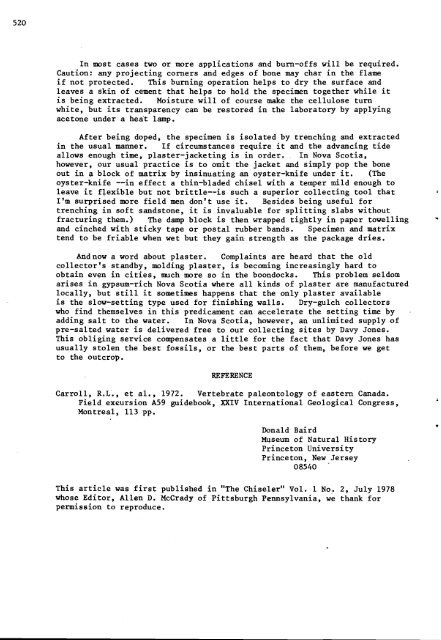E;*+ - Geological Curators
E;*+ - Geological Curators
E;*+ - Geological Curators
Create successful ePaper yourself
Turn your PDF publications into a flip-book with our unique Google optimized e-Paper software.
In most cases two or more applications and burn-offs will be required.<br />
Caution: any projecting corners and edges of bone may char in the flame<br />
if not protected. This burning operation helps to dry the surface and<br />
leaves a skin of cement that helps to hold the specimen together while it<br />
is being extracted. Moisture will of course make the .cellulose turn<br />
white, but its transparency can be restored in the laboratory by applying<br />
acetone under a hea't lamp.<br />
After being doped, the specimen is isolated by trenching and extracted<br />
in the usual manner. If circumstances require it and the advancing tide<br />
allows enough time, plaster-jacketing is in order. In Nova Scotia,<br />
however, our usual practice is to omit the jacket and simply pop the bone<br />
out in B block of matrix by insinuating an oyster-knife under it. (The<br />
oyster-knife --in effect a thin-bladed chisel with a temper mild enough to<br />
leave it flexible but not brittle--is such a superior collecting tool that<br />
I'm surprised more field men don't use it. Besides being useful for<br />
trenching in soft sandstone, it is invaluable for splitting slabs without<br />
fracturing them.) The damp block is then wrapped tightly in paper towelling .<br />
and cinched with sticky tape or postal rubber bands. Specimen and matrix<br />
tend to be friable when wet but they gain strength as the package dries.<br />
Andnow a word about plaster. Complaints are heard that the old<br />
collector's standby, molding plaster, is becoming increasingly hard to<br />
obtain even in cities, much more so in the boondocks. This problem seldom<br />
arises in gypsum-rich Nova Scotia where all kinds of plaster are manufactured<br />
locally, but still it sometimes happens that the only plaster available<br />
is the slow-setting type used for finishing walls. Dry-gulch collectors<br />
who find themselves in this predicament can accelerate the setting time by<br />
adding salt to the water. In Nova Scotia, however, an unlimited supply of<br />
pre-salted water is delivered free to our collecting sites by Davy Jones.<br />
This obliging service compensates a little for the fact that Davy Jones has<br />
usually stolen the best fossils, or the best parts of them, before we get<br />
to the outcrop.<br />
REFERENCE<br />
Carroll, R.L., et al., 1972. Vertebrate paleontology of eastern Canada.<br />
Field excursion A59 guidebook, XXIV International <strong>Geological</strong> Congress,<br />
Montreal, 113 pp.<br />
Donald Baird<br />
Museum of Natural History<br />
Princeton University<br />
Princeton, New Jersey<br />
08540 F<br />
This article was first published in "The Chiseler" Vol. 1 No. 2, July 1978<br />
whose Editor, Allen D. McCrady of Pittsburgh Pennsylvania, we thank for<br />
permission to reproduce.

















